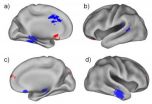(Press-News.org) When children are exposed to head and neck radiation, whether due to cancer treatment or multiple diagnostic CT scans, the result is an increased risk of thyroid cancer for the next 58 years or longer, according to University of Rochester Medical Center research.
The study is believed to be the longest of any group of children exposed to medical irradiation and followed for thyroid cancer incidence. It was published in the December 2010 edition of the journal, Radiation Research.
The data also might provide some insight about why the rates of thyroid cancer continue to rise, as the general public is increasingly exposed to higher doses of radiation through more frequently used imaging tests such as computed tomography (CT), said lead author Jacob Adams, M.D., M.P.H., an associate professor in the Department of Community and Preventive Medicine at URMC
"Ionizing radiation is a known carcinogen and, in fact, about 1 million CT scans are performed every year on children five years or younger," Adams said. "Although CTs and other imaging tests are an important diagnostic tool and radiotherapy is an important treatment modality for cancer, with everything comes a risk. Our study attempted to measure the very long-term impact on thyroid cancer from medical irradiation. Our findings strongly suggest that those individuals exposed to irradiation from multiple CT scans to the head, neck and chest during early childhood and individuals treated with radiotherapy to the upper body as children have a lifelong increased risk of thyroid cancer."
Adams and colleagues indirectly evaluated the future risks of modern patients by assessing the rates of thyroid cancer in a group that was treated with lower-dose chest radiotherapy in Rochester, N.Y., between 1953 and 1987. The cohort had been treated during infancy for an enlarged thymus, a condition that physicians used to believe was a health problem. None of the radiation administered was for cancer, and thus the research is not confounded by a susceptibility to the disease.
Adams re-surveyed the population between 2004 and 2008, and compared the health status of the group to their siblings who had not received radiation. Thyroid cancer occurred in 50 of the 1,303 irradiated patients compared to only 13 of the 1,768 siblings. The association between radiation and thyroid cancer remained strong even after researchers accounted for other factors that could contribute to thyroid cancer risk.
Radiation doses in the mid-century group overlapped with current medical practices; however, in general, higher doses and less precision were used years ago. Doses at the lower end of the study cohort were comparable to a diagnostic pediatric chest CT given today, the study said. Not surprisingly, researchers found that thyroid cancer risk increased with higher doses of radiation.
The Rochester study confirmed the findings of a pooled review of five earlier population studies, and adds to the literature by showing that, at least in children, the risk of cancer due to radiation exposure continues for a median of 57.5 years.
INFORMATION:
The James P. Wilmot Cancer Center at URMC and the National Heart Lung and Blood Institute funded the study.
Decades after childhood radiation, thyroid cancer a concern
2010-12-17
ELSE PRESS RELEASES FROM THIS DATE:
Wind turbines may benefit crops
2010-12-17
AMES, Iowa – Wind turbines in Midwestern farm fields may be doing more than churning out electricity. The giant turbine blades that generate renewable energy might also help corn and soybean crops stay cooler and dryer, help them fend off fungal infestations and improve their ability to extract growth-enhancing carbon dioxide [CO2] from the air and soil.
Speaking at the annual meeting of the American Geophysical Union, a scientific society, in San Francisco today, a researcher at the U.S. Department of Energy's Ames Laboratory and his co-researcher from the University ...
Teacher effort is linked to difficult students' inherited traits
2010-12-17
Challenging students take up more of their teachers' time—and the difference between a tougher student and an easier one appears to be genetic, according to a new study published in Psychological Science, a journal of the Association for Psychological Science. The study looked at young twins in the U.K. and asked their teachers how much of a handful they are.
"Policy-wise, there's a lot going on, blaming teachers for what's going on in the classrooms," says Renate Houts of Duke University, who cowrote the study with Avshalom Caspi and Terrie E. Moffitt of Duke, Robert ...
MRI scans reveal brain changes in people at genetic risk for Alzheimer's
2010-12-17
AUDIO:
People with a known risk for Alzheimer’s disease seem to develop abnormal brain function even before the appearance of amyloid plaques in the brain. A new study from Washington University...
Click here for more information.
People with a known, high risk for Alzheimer's disease develop abnormal brain function even before the appearance of telltale amyloid plaques that are characteristic of the disease, according to a new study.
Researchers at Washington University ...
New report outlines restoration activities to speed seagrass recovery in the Florida Keys
2010-12-17
Results of a five-year monitoring effort to repair seagrass damaged in a boat grounding incident suggest that restoration techniques such as replanting seagrass can speed recovery time. The finding is included in a new report released today by NOAA's Office of National Marine Sanctuaries.
The National Marine Sanctuaries Conservation Series report, "N-Control Seagrass Restoration Monitoring Report Monitoring Events 2003-2008," presents results of efforts to repair a nearly 1,000-square-foot (92.8-square-meter) swath of seagrass that was damaged on May 29, 2001, when a ...
Tiny 3-D images shed light on origin of Earth's core
2010-12-17
To answer the big questions, it often helps to look at the smallest details. That is the approach Stanford mineral physicist Wendy Mao is taking to understanding a major event in Earth's inner history. Using a new technique to scrutinize how minute amounts of iron and silicate minerals interact at ultra-high pressures and temperatures, she is gaining insight into the biggest transformation Earth has ever undergone – the separation of its rocky mantle from its iron-rich core approximately 4.5 billion years ago.
The technique, called high-pressure nanoscale X-ray computed ...
Extinctions, loss of habitat harm evolutionary diversity
2010-12-17
A mathematically driven evolutionary snapshot of woody plants in four similar climates around the world has given scientists a fresh perspective on genetic diversity and threats posed by both extinctions and loss of habitat.
The message from the study, appearing online ahead of publication in Ecology Letters, says lead author Hélène Morlon, is that evolutionary diversity -- the millions of years of evolutionary innovations contained in present-day species -- is more sensitive to extinctions or loss of habitat than long thought. And that, she adds, means conservation efforts ...
Emotional intelligence peaks as we enter our 60s, research suggests
2010-12-17
Older people have a hard time keeping a lid on their feelings, especially when viewing heartbreaking or disgusting scenes in movies and reality shows, psychologists have found. But they're better than their younger counterparts at seeing the positive side of a stressful situation and empathizing with the less fortunate, according to research from the University of California, Berkeley.
A team of researchers led by UC Berkeley psychologist Robert Levenson is tracking how our emotional strategies and responses change as we age. Their findings – published over the past ...
First measurement of magnetic field in Earth's core
2010-12-17
A University of California, Berkeley, geophysicist has made the first-ever measurement of the strength of the magnetic field inside Earth's core, 1,800 miles underground.
The magnetic field strength is 25 Gauss, or 50 times stronger than the magnetic field at the surface that makes compass needles align north-south. Though this number is in the middle of the range geophysicists predict, it puts constraints on the identity of the heat sources in the core that keep the internal dynamo running to maintain this magnetic field.
"This is the first really good number we've ...
PSA test better predicts cancer in men taking prostate-shrinking drug
2010-12-17
The PSA screening test for prostate cancer is not perfect. It can indicate cancer when none is present and miss life-threatening tumors. But a new study suggests the test is more reliable in men taking dutasteride (Avodart®), a drug widely prescribed to shrink an enlarged prostate gland.
Dutasteride lowers PSA levels by about half within six months. But the researchers found that even a slight rise in PSA levels among men taking the drug was a stronger indicator of prostate cancer, particularly aggressive tumors that require early diagnosis and treatment, than rising ...
Researchers suggest diagnostic criteria for posttraumatic stress disorder are lacking
2010-12-17
(Boston) - Current diagnostic procedures for posttraumatic stress disorder (PTSD) fail to adequately reflect research into the broad nature of a traumatic event, according to a study that will appear in the January print issue of Psychological Bulletin.
The relevancy of an individual's subjective experience in determining what constitutes a traumatic event has been a source of debate among PTSD specialists for years. The study concludes that both objective and subjective factors are relevant and that current PTSD criteria are missing several reactions that many trauma ...

